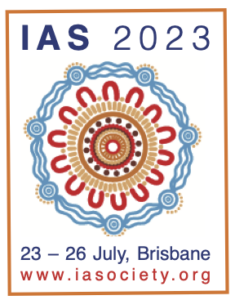12th IAS Conference on HIV Science (IAS 2023)
1 August 2023. Related: Conference reports, IAS 2023 Brisbane.
23 – 26 July 2023, Brisbane, Australia
 Introduction
Introduction
IAS 2023 was held this year in Brisbane, Australia, and as a hybrid conferences with a strong programme that included latest scientific progress in HIV treatment.
For those able to attend in person, there is no substitute for discussions that give broader perspectives to the presentations and that often lead to new collaborations with colleagues, researchers and activists in other countries.
But meetings will always be difficult to attend for those living furthest away. Funding and sponsorship to attend is becoming more difficult and visa applications from many countries can be difficult and easy travel is still not assured.
Recognising this, and building on the experience from COVID, it is notable that IAS 2023 was a hybrid meeting that enabled access to live presentations, next-day webcasts and online digital resources.
Australia has a long history of producing leading HIV research and is an example of one of the few countries where healthcare, including for HIV, is relatively unpoliticised – with a shared commitment to public health by all major political parties. In addition to HIV care, examples of leading public health initiatives include comprehensive early access to HCV drugs, HPV vaccines and HIV PrEP. Several sessions focused on the Australian progress to 95:95:95 targets for 2030.
It was good to see the conference remembering the late Professor David Cooper.
For all the focus on science, progress towards better health is dependent on people. David was one of the doctors who led many of the early responses to HIV in Australia and who collaborated internationally to make sure this response was also global.
Originally this two-yearly meeting was planned to focus on the treatment and pathogenesis of HIV, alternating with the IAS World AIDS Conferences which had a broader community scope.
This focus expanded over the years to have five tracks: basic science, clinical science, HIV prevention, social science and implementation. There were also three pre-meetings – on cure-related research, HIV-related migration and HPV-related research.
We include key highlights from the excellent rapporteur summaries to give a snapshot of the whole conference.
Much of the conference focused on global health goals for both treatment and prevention. Differences between regions include Eastern and southern Africa producing some of the highest rates of viral suppression on ART. The detail in calculations of targets though needs to include many populations where data is currently limited, including awareness of people who become disconnected from care and who then drop out of data.
Globally, the goal of 10 million people accessing PrEP by 2025 is unlikely to be met – although this might increase with access to new PrEP formulations.
We include separate reports on the launch of new WHO policies that emphasise that an undetectable viral load has a zero risk of transmission and an important clarification that with a detectable but highly suppressed low-level viral load (less than 1000 copies/mL) this risk remains very low and effectively zero, based on a new data review simultaneously published in the Lancet.
The meeting also focused on complications associated with ART, notably the problem of weight gain, hypertension, diabetes mellitus and metabolic changes.
The conference also included a symposium on the large international REPRIEVE study that could lead to earlier use of statins.
ART news included studies with long-acting injections, islatravir, lenacapavir, bNAbs and ways to deliver new formulations of these and other long-acting drugs. ART strategy studies included dual DTG/3TC ART, rapid ART and management of low-level vireamia on DTG-based ART.
Cure-related research included a potential cure case from a donor without the CCR5-delta-32 deletion and five children who had significant periods of viral load suppression off-ART. Mainstream new coverage of these studies were complicated by a media press conference held several days before the actual conference. This is a really unhelpful way to release important new study results and remains perhaps the most significant criticism for what looks like an otherwise exciting and impressive conference.
Rapid i-Base reports will be published online during the meeting and in the weeks after the conference.
Reports have been compiled by accessing the hybrid meeting as this year it was difficult to attend in person.
As in each of the conference sessions, i-Base also gives thanks and pays respect to the elders – past, present and future – who are custodians of the lands on which the conference took place.
Reports in this issue of HTB are linked below.

